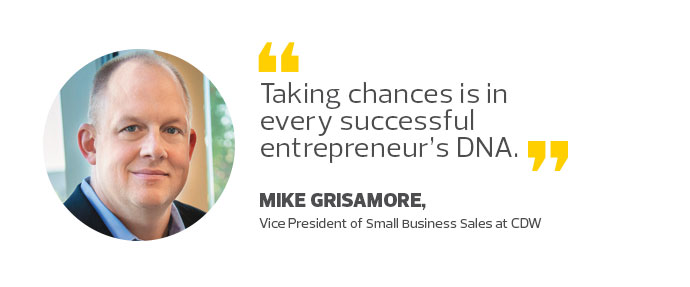SMBs Need to Take Risks to Grow — and Tech Can Help
For small and medium-sized businesses, 2017 holds great promise — but businesses can’t launch or grow without shouldering calculated risks. Taking chances is in every successful entrepreneur’s DNA.
Risk-taking is essential to growth and long-term survival, and technology plays a pivotal role in an SMB’s ability to achieve its goals.
SMBs are generally confident about the future of their companies. The findings of the National Small Business Association’s “2016 Mid-Year Economic Report” show that 45 percent of small businesses plan to implement new advertising and marketing strategies; 28 percent intend to expand into e-commerce; and 25 percent expect to launch new product lines this year.
Use Tech to Take Advantage of Opportunities
Every one of those three items represents a calculated gamble — one that has the potential to set a business apart from the competition and open up new opportunities. Each also will likely require IT investments for the gambits to pay off.
Regardless of the industry, companies can increase efficiency and expand their operations by implementing advanced technologies such as mobility and cloud computing. Conversely, businesses that fail to modernize their systems and infrastructure could miss out on opportunities.

A report from SCORE, a nonprofit association dedicated to helping small businesses succeed, notes that although most SMB staffs use mobile devices daily, 31 percent of these businesses lack mobile-friendly websites that can help attract customers. Likewise, only 29 percent use customer relationship management tools. No longer an expensive and complicated deployment, CRM systems available as Software as a Service (SaaS) offerings can help businesses estimate the sales pipeline and enhance customer service.
SMBs are not cloud-averse. A full 92 percent use at least one cloud-based solution, according to the SCORE findings. IT managers gravitate toward cloud models for cost-effectiveness, flexibility, ease of deployment, increased agility, enhanced security and predictability of cost.
Cloud computing, however, offers businesses another benefit that’s less widely touted: increased risk tolerance.
What that means in reality is that taking risks in technology is, well, less risky. For instance, providing a service to customers that creates peak demand windows for your data center needn’t require a complete installation of new servers.
Instead, your IT team can acquire compute in the exact quantities it needs when your business demands that processing prowess by bursting to the cloud. Cloud providers, with established infrastructures and services (and security), make it possible for businesses to try things faster and at less cost — and potentially less loss if they fail.
Gauging market interest is never an exact science, so cloud services enable businesses to scale to accommodate growth when needed and not before. That way, companies can conserve limited resources rather than having to budget for building out for demand capacities that may never come.
Keeping Employees Engaged
Beyond SaaS and Infrastructure as a Service solutions, adopting new collaboration technologies — such as video conferencing, instant messaging and social networking — can keep employees connected and improve engagement with clients and customers.
Plus, outfitting staff with mobile devices, whether company-purchased or through bring-your-own-device programs, not only boosts productivity, but also strengthens business continuity and disaster recovery readiness.
It’s easy to bemoan a lack of capital as the limiting factor in expanding operations or hiring new employees to tackle new opportunities. But by reducing on-premises technology and gradually migrating infrastructure and services to the cloud, companies can reduce the cost and complexity of their computing environment while also avoiding the risk associated with large capital expenditures.
After all, today’s modern technology has proved to be much more of a help than a hindrance for growing SMBs. To be fair, not embracing it could be the biggest risk of all.









